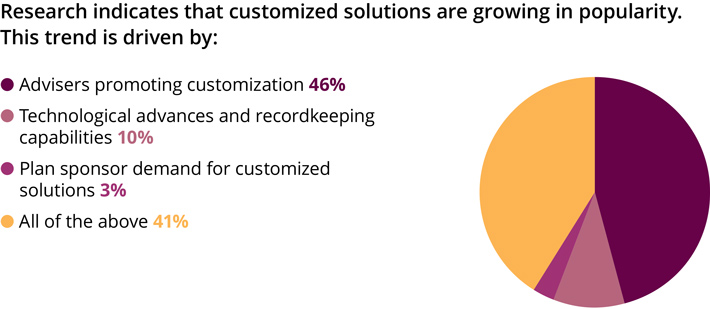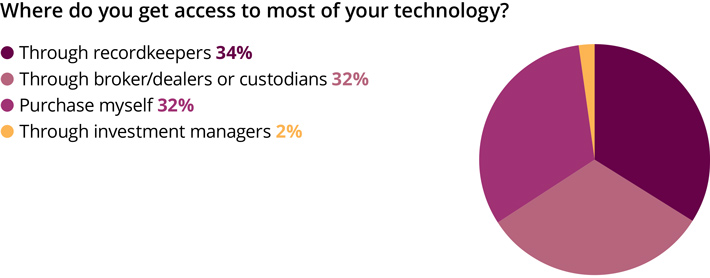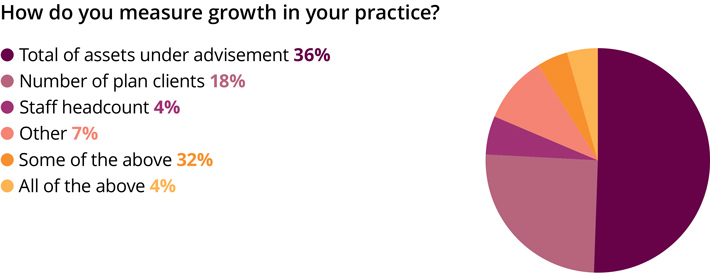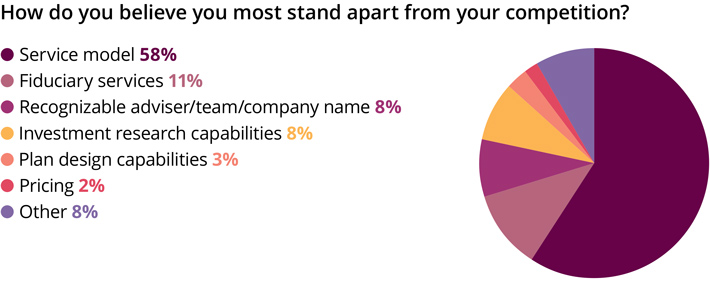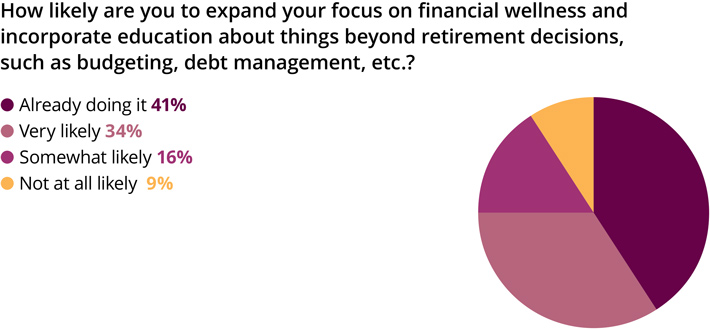2015 PLANADVISER National Conference
The Regulatory Environment
With Andrea Ottomanelli Magovern, acting branch chief of the Division of Investment Management at the U.S. Securities and Exchange Commission (SEC), taking part in the regulatory discussion at the 2015 PLANADVISER National Conference (PANC 2015), the focus was primarily on SEC actions.
Ottomanelli Magovern gave attendees an overview of money market fund reforms adopted by the SEC in 2014. The rule amendments require providers to establish a floating net asset value (NAV) for institutional prime money market funds, which will allow the daily share prices of these funds to fluctuate along with changes in the market-based value of fund assets. The reform also provides nongovernment retail money market funds with new tools, known as liquidity fees and redemption gates, to address potential runs on fund assets.
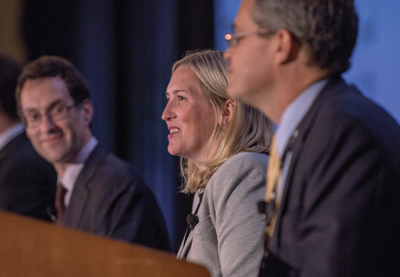 Photo by Josh RitchieAccording to Ottomanelli Magovern, the establishment of a floating NAV addresses first-mover advantage. During the financial crisis of 2008, investors had an incentive to get out of money market funds at the first sign of trouble because those who did not were left to make up the difference between the $1 per share published price of the funds and the shadow price, she explained. “We found that most of these first movers were institutional funds, so we want to steer the reform in that direction.” Ottomanelli Magovern added that a floating NAV also provides risk transparency; investors can see there is risk with a share value that goes up and down.
Photo by Josh RitchieAccording to Ottomanelli Magovern, the establishment of a floating NAV addresses first-mover advantage. During the financial crisis of 2008, investors had an incentive to get out of money market funds at the first sign of trouble because those who did not were left to make up the difference between the $1 per share published price of the funds and the shadow price, she explained. “We found that most of these first movers were institutional funds, so we want to steer the reform in that direction.” Ottomanelli Magovern added that a floating NAV also provides risk transparency; investors can see there is risk with a share value that goes up and down.
David Levine, a principal at Groom Law Group, Chartered, told attendees that institutional investors, including retirement plans, are starting to discuss the implications of the money market fund reform, and advisers often lead the conversations. They are helping plan sponsors review their current money market funds and determine whether they need to move to government funds.
Ottomanelli Magovern said compliance with the new rules is expected by October 14, 2016. “About two-thirds of retirement plans have money market funds,” she said. “We want to get the word out because we’re not sure plan sponsors are focused on it.”
Ottomanelli Magovern told conference attendees other priorities for the SEC’s investment and enforcement divisions include getting better disclosures from registrants; looking into liquidity risk management—how derivatives and funds invested in derivatives are managed; and examining transition and succession planning for advisers.
One notable SEC action is the ReTIRE initiative. Levine said, “The SEC marches to its own drum, but there are a lot of similarities” between this initiative and the Department of Labor (DOL)’s proposed fiduciary rule. The ReTIRE initiative considers factors such as: What is a reasonable basis for adviser recommendations, and who is responsible for oversight? It also looks into deceptive marketing practices, according to Levine.
Speaking of the DOL fiduciary rule, both Levine and Jamie Fleckner, a partner at Goodwin Procter LLP, told conference attendees they should expect the DOL to move forward on it. “[The department] may back off on some disclosures, but it will keep the focus on unconflicted advice,” Fleckner said, adding that there may, for example, be some relief concerning rollovers for those advisers affiliated with product providers. “But not everyone will like the changes.”
 Photo by Josh Ritchie
Photo by Josh RitchieThe Flavors of Fiduciary Service
Advisers may take on a variety of fiduciary roles. But,
right now, the fiduciary investment advice industry is in a state of flux, and
it looks like the number of 3(38) investment managers is set to grow.
Daniel Notto, senior vice president and senior retirement plan counsel at AB, formerly AllianceBernstein, explained to conference attendees that Section 3 of the Employee Retirement Income Security Act (ERISA) is the definitional section. Subsection 3(16) contains the definition of a plan administrator, which includes duties of government and retirement plan participant disclosures.
A few recordkeepers have begun taking on a 3(16) role, moving from outsourcing to performing administrative tasks themselves and functioning as fiduciaries, noted Grant Arends, president of consulting services at Alliance Benefit Group. However, the trend is in its infancy. “Recordkeepers fear a fiduciary role because they process hundreds and even thousands of transactions per day; it’s scary to have fiduciary responsibility for those,” Arends noted.
Craig Bitman, a partner at Morgan, Lewis & Bockius LLP, added that there has been no explosion in recordkeepers or advisers taking a 3(16) role because of all the litigation about plan document language and disclosures. “This seems to be where you get the one-off, single-plaintiff litigation that is annoying and time-consuming to deal with,” he said.
It’s tricky, he added, because plan sponsors are disinclined to give up all control; for example, they many want to handle messaging to participants on their own. “There are all shades of gray in between the three types of fiduciary service, for which plan sponsors can retain responsibility,” he noted. Advisers should make sure plan sponsor clients line up their plan document with a provider’s 3(16) contract and duties, because someone still named in the plan document could get dragged into a lawsuit.
Arends suggested that if plan advisers are looking for 3(16) services for clients, they should read the fine print in contracts, because 3(16) can mean different things from different providers.
ERISA also provides definitions of 3(21) investment advisers and 3(38) investment managers. Due to the DOL’s proposed fiduciary rule, plan sponsors are increasingly looking for fiduciary services, Arends said.
As a result of the proposed rule, just about everyone who provides investment services will be a fiduciary. “Like it or not, anyone who wants to stay in the business will have to accept being a fiduciary,” Notto told conference attendees.
The main importance of a 3(21) adviser is setting a process for selecting and monitoring funds and making a recommendation, but the retirement plan committee actually votes and makes the final decision about investment choices, Arends said. He noted that many plan sponsors are migrating to 3(38) services because, 99% of the time, they accept an investment adviser’s recommendations, yet, in doing so, they take on all the fiduciary responsibility for selection.
According to Bitman, the U.S. Supreme Court decision in Tibble v. Edison International also led plan sponsors to pay more attention to the duty to monitor investments. “From a litigation perspective, the difference between 3(21) and 3(38) is somewhat marginal,” he said. “Advisers will get dragged into a lawsuit regardless of which fiduciary role they take. I think a lot of advisers are realizing it’s not much of a step to go from 3(21) to 3(38).”
Bitman observed that the processes for performing either 3(21) or 3(38) fiduciary functions is the same. The difference is between making recommendations and executing decisions. “The timing is better if you’re a 3(38),” he said. “If something happens in the market, a 3(38) can make changes faster than if he had to wait for a plan sponsor decision.”
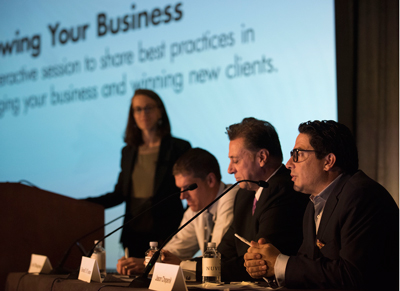 Photo by Josh Ritchie
Photo by Josh Ritchie Participant Advice
As the industry braces for the new definition of fiduciary
from the Department of Labor (DOL), what makes the fiduciary proposal so
relevant to the industry is its potential impact on compensation, said Marcia
Wagner, managing director of The Wagner Law Group.
“If you are a fiduciary, then you cannot receive what is known broadly as variable compensation,” she said. Under the proposed rule, commissions, 12b-1 fees and revenue would be much harder to justify, and that, she said, is what gives the proposal “all its power, its teeth.”
The current DOL definition of fiduciary is more than 40 years old. Under this proposed newstandard, Wagner said, most retirement plan advisers will be investment advice fiduciaries; those who need or want to use variable compensation will have to operate under the soon-to-be-finalized rules, especially the best interest contract (BIC) exemption. Some advisers, on the other hand, might try to keep their counsel within the rubric of education, confining their comments to participants to general information on investing.
The alternative is a close relationship with an ERISA attorney to learn how to stay compliant with the BIC exemption. This exemption from the proposed prohibited transaction rules allows advisers to receive variable compensation, so long as they commit in writing to keeping client interests ahead of their own when making recommendations. Calling the BIC exemption “complex,” Wagner listed some of the requirements an adviser would need: a contract, robust disclosures about the compensation fee, and intensive conflict of interest disclosures. “Only a lawyer can walk you through this,” she cautioned.
Capturing rollovers is a distinct target of the fiduciary rule changes, Wagner said. “The DOL is extremely concerned with the embedded conflict of interest and cross-selling, where you take the long-term trust you’ve gained to potentially sell something people don’t need at a higher cost.”
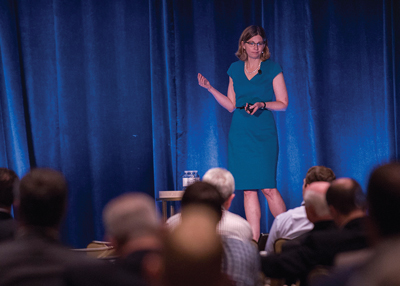
Photo by Josh Ritchie
DC in Perspective
Plan advisers are the linchpin in the constantly evolving
retirement landscape, said Anne Lester, portfolio manager and head of
retirement solutions, J.P. Morgan Asset Management.
From improving outcomes to dealing with changing regulations, Lester said, every decision will be easier to make, every question easier to answer if the adviser asks: Is what I’m doing going to increase the probability that someone will get to retirement safely? “Every choice we face is going to be clearer, in that context,” she said.
The current retirement landscape has several notable features, according to Lester. Government is increasingly interested in seeing people retire with adequate resources; plan sponsors motivated by business risk management also want to do the right thing for employees; and demographic shifts are adding to financial market anxieties. All of these factors mean the role of the adviser is even more important.
Lester called the daily work of advisers essential to shifting participant outcomes and supporting plan sponsors. “Helping employers to navigate and understand the landscape is an important and powerful job,” she said.
“We’re struggling to understand living longer, and it’s key to help plan sponsors understand this,” she said. “As we live longer, are our financial assets lining up behind that?” Although the Baby Boomers have accumulated substantial wealth, she noted, their average individual net worth—about $200,000—is mostly in illiquid assets such as residential properties, other nonfinancial assets and pooled investment funds. “This generation’s liquid assets may not be enough to meet their consumption in retirement,” she said.
Individuals face a range of multifaceted risks, some of which they can control and some they cannot. To begin with, individuals have it in their own power to decide whether they are going to save for retirement.
Accumulation risk is determined by the amount someone saves. Individuals saving at 8%, with a company match of 4%, are probably on track to meet their retirement goals. User risk—i.e., the degree to which an individual allocates assets properly and assumes the right level of risk—is another measure, and most people, Lester said, are unaware of how much risk is right for them. Often, however, their suboptimal behaviors, such as disengaging from the plan when the markets are rocky, or panicking when they open their statements, then selling out can be mitigated with automatic features, she said.
Market risk comes in several varieties, Lester said, from garden-variety volatility to cataclysmic events such as the Great Depression or the crash of 2008. “Most people have only experienced falling interest rates,” but rising rate risk still exists, she pointed out. Inflation might return in the future, and longevity risk, which individuals can control to some extent with diet and exercise, is another factor ultimately beyond people’s control.

Photo by Josh Ritchie
Optimizing the Investment Menu
At one point, the trend in defined contribution (DC)
retirement plans was to expand the investment menu and have self-directed
brokerage accounts (SDBA) available, but with all the behavioral finance
information that has been shared, plan sponsors and advisers understand that an
expanded menu often confuses participants, noted Paul Temple, senior vice
president for retirement sales at OppenheimerFunds. So, now there is a move
back to simplification of investment menus, he said.
Michael Rosenberg, executive vice president and head of investment-only defined contribution (IODC) distribution at Prudential Investments LLC, agreed that the current trend is to streamline and simplify investment menus. He added that plan advisers are scrutinizing participant demographics and trying to create menus that work for each individual client’s plan. With this in mind, advisers need an understanding of what investment providers offer and what offerings suit a particular client’s participant demographics.
“Advisers will have to know more about the products in the marketplace, share classes and fees,” he said. “As an industry, we are focused on participants, who are not, as a whole, sophisticated investors. So we’re trying to understand their behaviors and their challenges.”
According to Temple, one of the great developments in the industry over the past five to eight years has been the increasing availability of information about plans, for sponsors and advisers. “Benchmarking has created a lot of intelligence,” he said. “With this, we are starting to see an evolving of the construction of target-date funds [TDFs] and qualified default investment alternatives [QDIAs].” Temple said this enables plan sponsors to re-enroll employees into the plan and continue to educate them—and not just with lessons about investments: Plan sponsors and advisers can focus on other things to help employees with their goal of overall financial wellness, such as debt reduction and health care costs.
Steven Geisert, a senior vice president at PIMCO, added that, clearly, the role of the core menu is diminishing as the role of TDFs and QDIAs takes over. At some point, investments on the core menu become the ingredients for these custom solutions.
In addition, instead of looking at active management vs. passive management, the industry is starting to consider the active/passive combination as a form of investment diversification, Temple said.
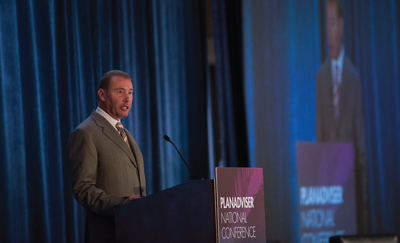 Photo by Josh RItchieLeading-Edge Technology
Photo by Josh RItchieLeading-Edge Technology
Technology must be ready to support advisers in what they do
best, helping participants retire, said Christen Marsenison, vice president in
client services and delivery at Envisage Systems. Providers have an eye on what
tomorrow looks like, as they scout solutions for what will make platforms move
forward, she said.
One challenge for advisers is juggling day-to-day responsibilities and the associated technology tasks, added Steven Shackelford, senior vice president, strategic sales at Aspire Financial Services. Managing data is another big issue, he said. “Advisers are starting to move toward consolidating vendor relationships in order to get the data they need.” A top concern for them is how to adapt the technology but still leave time for their daily agendas.
Advisers are mulling over how to use the many available resources to provide better service and remain profitable, and they continuously struggle with a number of questions, said Anders Smith, senior vice president at Nuveen Investments. Those questions include: How do I use this technology to provide better services for my plan sponsors? How can I be more profitable in terms of how I run my business? How do I get more out of each dollar coming in? “We believe technology can enhance a service model,” Smith said.
Shackelford noted that many resources exist to help advisers expand their business, such as private-labeling capabilities, which can make a business much more viable in the marketplace. “It makes you larger than what the client sees,” he said. “You can expand your practice and boost visibility in the industry.” Partnering with the right institutions allows advisers to leverage the strength of the existing marketplace instead of building custom solutions from scratch.
Technology can also influence how advisers manage retirement plan practices and deliverables. Instead of holding individual client meetings, Smith explained, advisers can do webinars, using an iPad pre-loaded with information and materials, thereby saving the cost of an assistant.
An ongoing issue with profitability means that advisers should look at their business more as a business. “They’re putting in plan information and seeing what it costs them to manage a plan,” Smith said, adding that advisers try to determine a billable hourly rate and how much time they spend on a specific plan. “Advisers have a hard time tracking [hours] spent with each client,” he said. “It takes time to track time.”
Gamification is gaining traction, Marsenison said, referring to a practice used to reward participants for certain behaviors and to increase enrollment. A recent study showed that 49% of men and women older than 28 spend four hours a day playing games on devices or computers, making the trend all the more vital for younger plan participants, she pointed out.
Millennials’ communication preferences are also an important topic. Marsenison cited, for example, research showing Millennials’ preferences for online support: Baby Boomers ask the hotel concierge for a recommendation, but Millennials go straight to Yelp.
Examining such preferences could benefit an adviser’s own practice, for example, if he starts to use alerts as a communication tool, Shackelford said.
 Photo by Josh Ritchie
Photo by Josh RitchieSurveying Your Clients
The information advisers can glean from client surveys can
boost profits substantially, suggested Tim Seifert, vice president and national
sales manager at Lincoln Financial Group.
Fidelity Investments has been surveying plan sponsors since 2008, said Derek Wallen, senior vice president and head of defined contribution investment only (DCIO) sales at the company. He said Fidelity focuses on plans that use an adviser and employs a third-party research firm to conduct the surveys, not identifying Fidelity as the survey sponsor.
Advisers might want to consider asking the same questions that Fidelity poses, Wallen said, starting with: Are you looking to switch your adviser? In the company’s latest survey, 17% of sponsors answered in the affirmative. Next, ask why, he suggested. Fidelity discovered that 43% of those plan sponsors are looking for an adviser who is more knowledgeable about defined contribution (DC) or defined benefit (DB) plans.
Drilling down further, panelists said, plan sponsors are looking for an adviser who offers proactive suggestions for improving plan performance. Sponsors also want an adviser who proactively consults on plan design, fiduciary responsibilities, investment option selection and monitoring, cost minimization and regulatory changes, Wallen said.
“There is also value in asking the same question over several years to look for a trend,” Wallen added.
“The No. 1 reason plan sponsors use an adviser is investment expertise, so ask them about that,” Wallen said. “Ninety-seven percent of plan sponsors review investments at least annually. Eighty-three percent provide investment advice or guidance to participants. Eighty-nine percent of sponsors say it is acceptable for their adviser to provide investment advice outside the plan, and 63% say an adviser’s willingness to take on formal fiduciary duties is very important.”
Finally, Wallen suggested that, when surveying clients, advisers “aggregate the results of your surveys to learn about your whole book of business, and consider tying in survey results to bonuses.”
Lincoln Financial’s top adviser teams spend an hour each week surveying clients, Seifert said. He described the process as having five steps: 1) determine your focus; 2) decide on the methodology, whether you want to conduct informal interviews or a formal survey; 3) create the questionnaire; 4) send a pre-survey invitation, and then go live; and 5) evaluate the data, and identify areas to improve your practice.
The teams explore nine key areas, instructing the sponsors to rate their performance on a scale of 1 to 5, with 5 being the most favorable, Seifert said. The topics they want to learn about are: 1) the sponsor’s perception of the business relationship; 2) the professionalism of the adviser team’s business practice; 3) the standard of the team’s support staff; 4) the team’s financial knowledge; 5) the team’s understanding of the sponsor’s needs; 6) the team’s implementation of solutions; 7) the range of the team’s financial services; 8) the effectiveness of the team’s communication; and 9) the sponsor’s satisfaction with the team’s financial review process.
The D’Aiutolo Institutional Consulting Team at UBS Financial Services does not conduct formal client surveys because it serves 120 401(k) plans, covering 150,000 participants, and “each client is different,” said Paul D’Aiutolo, institutional consultant. “Instead, we hold roundtables with plan sponsor clients, sometimes including the recordkeeper, and we conduct informal surveys at every client review,” he said.
What D’Aiutolo typically asks first is: How important is the client’s 401(k) to the wider business? Next, he probes: What services matter most? Governance, plan health or outcomes? The third question he frequently asks is: Would you be willing to give us a reference? Fourth: What might prompt you to select another adviser or recordkeeper?
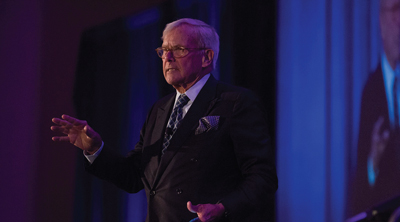 Photo by Josh RitchieGrowing Your Business
Photo by Josh RitchieGrowing Your Business
Referrals are good, but they can only take retirement plan
advisers so far in growing their businesses, said Edward O’Connor, managing
director and head of retirement services at Morgan Stanley Wealth Management.
A quick poll of attendees found 71% depend on referrals from strategic partners or other professionals to grow their business, 20% rely on referrals from clients, and 10% use cold calling.
“Marketing may be old-fashioned, but it’s still an important part of growing your business,” O’Connor said.
Jim O’Shaughnessy, managing partner at Sheridan Road Financial, said he sees any disruption in the industry—from lawmakers’ view of the industry to new technology—as an impetus for growth. “We went from a broker/dealer [B/D] model, to a 3(21) investment adviser model, to a 3(38) investment manager model,” he said. “I see a trend of working more with participants. We plan to hire more so we can move into worksite services.”
O’Shaughnessy added that advisers should embrace technology; it provides an opportunity to reach Millennials.
O’Connor said that, for those in wealth management handling retirement plan rollovers, things may get more difficult with the DOL’s fiduciary rule. He suggested that those advisers start encouraging participants to keep their assets in their retirement plans.
There are several trends and channels retirement plan advisers can use to grow their businesses. Jason Chepenik, managing partner at Chepenik Financial, told attendees that endowments and foundations area natural progression from retirement plans. “Perhaps this is the biggest opportunity to grow your asset base without losing sight of what we’re about,” he said.
Chepenik said his best idea ever was to get involved in the community. “Don’t do it to get clients. Do something you’re passionate about and enjoy,” he said.
He observed that the new trend of financial wellness education for employees presents another opportunity for advisers to grow their business, as does moving into the nonqualified deferred compensation (NQDC) space. However, if moving into NQDC, advisers need a team member highly specialized in that market, he cautioned.
Having the right team is a key to success, O’Connor agreed. “I’ve not met a successful retirement plan adviser who doesn’t have a well-run team. Put the right team together,” he urged.
 Photo by Josh RitchieRecordkeeper Partners Are Critical to Success
Photo by Josh RitchieRecordkeeper Partners Are Critical to Success
According to Joe Ready, executive vice president of Wells
Fargo Institutional Retirement and Trust, dedicated retirement plan advisers
have, in their recordkeeper, probably their most effective service delivery
partner. And if they do not, it’s time to find another recordkeeper.
“Mutual agreement upfront and mutual service from the recordkeeper and the adviser are foundational to good plan sponsor outcomes,” Ready said. “When the recordkeeper supports the adviser, and the adviser knows the recordkeeper inside and out, it absolutely leads to better ideas and better best practices.”
Working together throughout the process of running a retirement plan will certainly bring better outcomes and increased satisfaction from the plan sponsor, agreed Randy Long, managing principal at SageView Advisory Group. He observed that, earlier in his career, winning a new advisory client almost always meant converting it to a new recordkeeper.
“Today, the process essentially works in reverse,” he observed. “Over the last 10 or 15 years, the industry has really evolved, and we’re commonly winning new clients through our recordkeeper. It’s a client on the recordkeeping platform looking for a new adviser, which only makes things easier from the participant perspective.”
The benefits that arise from close coordination between adviser and recordkeeper are myriad, the pair explained. From greater plan management efficiency to more advanced reporting and faster data updates, a skilled recordkeeper/adviser team can really turn up the heat on plan and performance.
Some advisers believe it important to maintain a coolheaded distance from the recordkeeper in order to promote an image of independence and transparency among clients. Long affirmed that stance, but said it did not need to preclude the adviser from coordinating with the recordkeeper or being an effective partner.
“You can maintain your independence while presenting services in a highly coordinated and effective way,” Long said. “That’s something we have strived pretty successfully to do. Just remember: The end goal is always to put the client first and keep the client happy, both for the adviser and recordkeeper.”
 Photo by Josh Ritchie‘Stressed Out and Stretched Thin’
Photo by Josh Ritchie‘Stressed Out and Stretched Thin’
John Hancock Retirement Plan Services started its annual
Financial Stress Study a year ago because the company “wanted to know what
prevents people from saving for retirement,” said Patrick Murphy, president of
John Hancock Retirement Plan Services. “Finance is the No. 1 cause of stress,
and, while there are competing priorities, retirement planning remains a top
concern,” Murphy said.
John Hancock learned through the study, conducted by Greenwald and Associates, that 45% of working-age households do not own a retirement account. Workers between ages 25 and 64 have an average balance of $2,500. For those near retirement—ages 55 to 64—the average balance is $15,000, Murphy said, and total savings is $104,000. This is according to the National Institute on Retirement.
The survey also indicated that 75% of people have experienced moderate to high stress in the last six months. Sixty-six percent said their finances cause stress, and, of this group, 61% said the stress manifests itself psychologically or physically. Forty percent feel anxious, 39% feel overwhelmed, 24% have insomnia, 22% have headaches, and 16% have an upset stomach.
“Overall, financial stress in the workplace costs employers $300 billion a year in lost productivity and absenteeism,” Murphy said, citing data from the Word Health Organization.
The good news, he said, is that employers are beginning to recognize this problem and take action. Seventy-six percent of employers said they are somewhat or very likely to create a financial wellness program in the next six months. “Companies are starting to think more about the emotional wellness of their employees,” Murphy said. “Stress management is a critical component of a company’s wellness strategy and can be addressed through workshops, webinars and targeted communication tools.”
Asked about their long-term concerns, workers first cited saving for retirement (69%), followed by paying down debt (65%), and managing Social Security and Medicare (42%). More than one-third (36%) of women fear they could one day be poor, compared with 20% of men. Forty-five percent worry about saving for a child’s education, 59% of households earning less than $50,000 are concerned that Social Security will not be there for them, yet 79% say having a retirement plan helps ease worries.
“What can you do? Implement intelligent plan design with automatic features,” he said to the advisers in the audience, adding, “Six is the new three,” in reference to 6% replacing 3% as the automatic default savings rate. “Ten percent of workers opt out of 3%, but 11% opt out of 6%,” he said. “If the participant is under 30, if you automatically enroll him, his retirement readiness doubles.”
Financial education is also key, he said. “Thirty-six percent of respondents said getting financial education would help their situation,” he said. “Forty-two percent have started saving for retirement, 43% say they are ahead or on track, but only 20% have determined what they need. It’s clear: People need relevant and targeted communications and education. Help them with budgeting. Remove psychological roadblocks for saving.”
 Photo by Josh RitchieStable Value
Photo by Josh RitchieStable Value
Stable value accounts come in several types with varying
structures and different nuances, but all provide the same level of protection
and guarantees, said Jeffrey Stein, vice president, senior research analyst at
Morgan Stanley Wealth Management. “They guarantee principal, plus accumulated
interest,” he explained, and “participants may transact at book value, or
guaranteed value, at all times.”
The general account product brings a guarantee provided through a group annuity contract based on the claims-paying ability of the insurance company, Stein said. These are “spread” products for the insurance company, without fee transparency. Some insurance companies disclose fee information but are not required to.
In a stable value separate account, the guarantee is again made through a group annuity contract, but the product contains a credit enhancement, and the assets are segregated away from the general account, Stein said.
The collective trust or pooled fund, usually offered by more traditional asset managers, is a way for smaller plans to gain access to stable value. The guarantee is made through a synthetic or traditional guaranteed investment contract (GIC) or through an insurance company separate account.
Choosing the best stable value product is a matter of weighing the different characteristics of each, according to Jeb Graham, retirement plan consultant and partner at CapTrust Financial Advisors. “A separate account does not have as many hands,” he observed. “If you use the wrap providers, from a fiduciary standpoint there is a lot less risk.”
Also from a fiduciary standpoint, the soundness of the insurance company is critical when choosing a general account product, Graham said. The portfolio does not enter into the decision. “You don’t and can’t do any analysis on the portfolio,” he pointed out, “and your assessment from an investment perspective is going to be very different than it would be for a separate account product.”
Graham advised looking at the portfolio as another type of fixed-income portfolio: “not good or bad, just different,” he said. Transparency of fees is another consideration.
One reason to choose a single-insurer product over multiple wrap providers: the possibility of getting a better crediting rate, Graham said. The level of risk must be factored in. He pointed to the financial crisis of 2008, when book-to-market ratios were in the high 80s. “We were fortunate that none of these insurers imploded.”
Using a single insurer can bring real risk. Insurance companies that offer general account products will, of course, declare such products financially sound. “But, from a pure risk standpoint, it’s probably a safer bet, if you’re a fiduciary, to have multiple insurers involved,” Graham said. “That’s why some consultants believe very strongly that multiple insurer products are more favorable, and some believe the general account products are better.”


